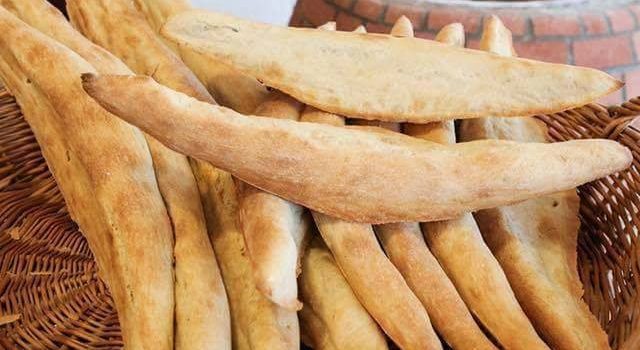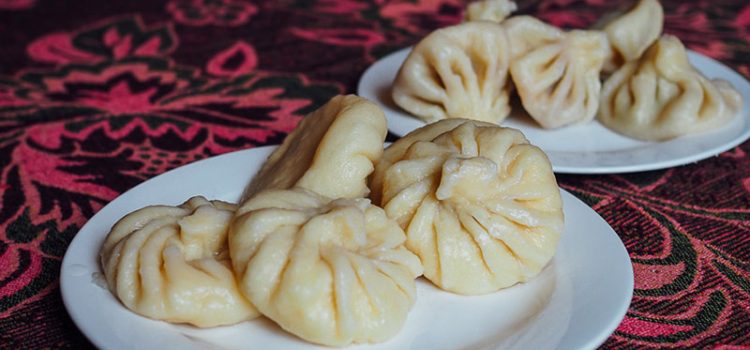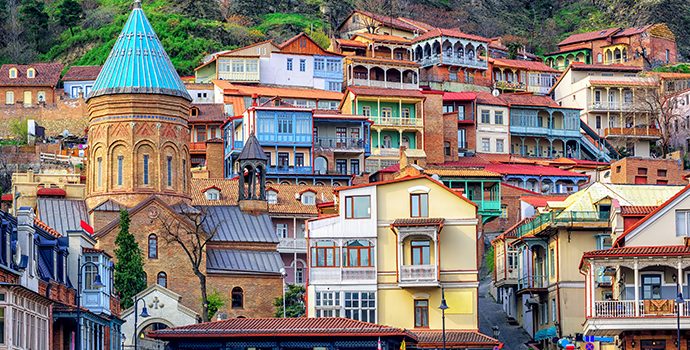The World Talks about Georgian Shoti Bread
Georgian cuisine is well-known across the world. Various websites such as FoodAtlas or Culinary Backstreets have devoted multiple articles to the traditional Georgian dishes. One of the most celebrated Georgian foods is Shoti Bread (in Georgian “Shotis Puri”). This canoe-shaped bread is distinguished not only by its taste but also the way it is traditionally baked.
“It is incredibly hard work. Marekhi’s day begins at 4:30 a.m., when she and her co-worker Nona Khatiashvili (no relation) start making giant tubs of dough in the back of the low-ceilinged bakery, ready to be baked into the long, flat loaves of bread that Georgians call shoti. It’s a ritual of daily life here.
As they turn and press the heavy mix of flour, water, salt, and yeast, it is almost up to their elbows.
Everything is done by hand. That’s the special ingredient,” reads Culinary Backstreets’s article about the bread.
Shoti bread is a flat bread soft inside and crispy outside. It is baked vertically in a sunken stone oven (tandoori) known as “Tone” in Georgian. Traditionally in order to bake Shoti all you need is a mix of flour, water, salt, and yeast. After mixing you should knead the dough by hand.
“The freshly baked bread is then placed on wooden racks to cool, and it is usually sold wrapped in a sheet of paper.
Shotis puri is consumed as an everyday bread, but it is especially popular during festive events such as Easter, Christmas, and birthdays,” TasteAtlas about Shoti bread.
Source: Georgianjournal.ge
Georgian restaurants in Kiev, Ukraine winning the hearts of their guests
Kyiv Post, Ukraine’s oldest English language newspaper has recently published an article about Georgian restaurants in Kiev. The article familiarizes the readers with particular Georgian flavor which was influenced by western and eastern traditions over the years.
“But Georgian cuisine has today developed its own unique flavor, and their khinkali (dumplings) and khachapuri (cheese bread) are the country’s calling cards.”
The first restaurant is Gogi (a Georgian male name) which offers a wide range of Georgian dishes, desserts and, wines accompanied by folk music playing background. Some of the dishes are Khinkali filled with meat, cheese, potato and mushrooms, Adjarian Khachapuri (a boat-shaped cheese bread) and Pkhali (a vegetarian appetizer).
The second restaurant is Suluguni (a type of Georgian cheese from the western region Samegrelo). The restaurant is located in the city center having a stylish design, a terrace, and lively Georgian music. The restaurant offers signature and classic Georgian dishes including a house-made drink such as a type of yogurt Matsoni.
The name of the third restaurant is very interesting – Oi, Mamo! Tse bulo v Tbilisi (Oh, Mom! It was in Tbilisi). The restaurant offers a wide choice of traditional Georgian dishes including, the kada dessert made with walnuts and cream. The legend behind the creation of the restaurants says that once a Kiev citizen visited Tbilisi, the capital of Georgia and was impressed by a Georgian family café – Tbilisi. Then the family moved to Kiev and opened the restaurant.
The restaurant Khinkali has five different zones for business meetings, celebrations or a summer terrace.
“The menu includes khinkali with various fillings: mutton and green adjika, veal and basil, veal tongue and mushrooms in a rich cream sauce, the classic mix of pork and veal, shrimps in cream sauce, and spinach and mushrooms.”
Besides, Khinkali offers the classic Adjarian khachapuri and the tasty pan-fried chicken tabaka.
The restaurant 99 Lari (“lari” is the name for Georgian currency) serve three types of Khachapuri boat-shaped Adjarian, circular Imeretian, and Megrelian, also circular, but sprinkled with cheese, kharcho soup with beef and tomatoes, Georgian desserts as well as vegetarian dishes such as roasted vegetables with walnut cream. 99 Lari gives out free drinks and appetizers from the chef.
And, lastly, Matsoni restaurant named after the Georgian yogurt “Matsoni”. The restaurant serves Matsoni made with fresh milk from small farms, Megrelian Khachapuri, chakhokhbili stewed turkey with fresh herbs and two varieties of Matsoni. The cozy atmosphere of the restaurant attracts guest on cold winter and fall days.
Source: Georgianjournal.ge
Winter skiing resort – Gudauri
Gudauri – young and rapid developing winter sports resort located at Kazbegi region of Georgia, 120 km from Tbilisi, at the height of 2,196 m (about 7,200 feet) near the Cross Pass. Skiing season lasts from December to April, comfort skiing on all routes. In May skiing is possible on the five (highest) lift or even on the second lift in snow years.
Routes and lifts: in Season 2018-2019 is going to be open a new Ski-Lift to Kobi.
- “Pirveli” 1992-2065m- 3 seats (со снежными пушками и вечером освещена),
- “Soliko” 2157-2709m- 3 seats,
- “Kudebi” 2703-3006m – 3 seats, (на вершину Кудеби)
- “Snow Park”- 3 seats, 2720-2846m
- “Sadzele”- 4 seats, 2795-3276m, (to Sadzele).
- gondola “GudAura” – 2724-2777m, 10 seats,
- “Shino”-, 6 seats, 2186-2724m
- “Zuma” – 2151-2210m
- Alpina: 2300-2320m
- Bombora: 2740-2780m
- Baby
Snow park and SunKid people mover – 300m – FREE.
Cable railway operates from 10 to 16 for any number of skiers on routes. Cable railway may be closed in rare occasions of very low visibility or high wind. Cable railway is equipped with standby power generator for blackout protection.
SUMMER SEASON: From 16th of July during the summer season all the ski lifts will be working every day from 10:00 till 16:00. Price List:
One Ride – 5 Gel Sadzele (Gudaura, Snow Park, Sadzele) – 15 Gel Bike Pass (One day) – 12 Gel Summer Card – 60 Gel 20% discount on any category tickets for groups of 10-20 persons, 30% discount on any category tickets for groups of 20 people and more.
source: www.Gudauri.info
Paragliding in Gudauri
Having decided to jump you will be able to sail above the earth and see its true beauty, because nothing can escape from your sight. Paragliding can really give you the feelings, emotions and experiences, which nothing can be compare with!
Paragliding in Gudauri takes place in winter and summer, in the case of good weather.
We offer our guests the slopes of the mountains Kudebi and Sadzele. All flights are carried out in tandem system: instructor and passenger.
Pilot-instructors of a company use brand new, certified paragliding equipment. They have minimum 10 years of experience.
About prices and additional information please write us: Georgiantour@georgiantour.ge , Georgian_tour@yahoo.com
10 things to do in Tbilisi
What is it about Georgia lately? The country (not the US state) seems primed to be one of the hottest tourist destinations for 2017, as travellers are freshly obsessed with the fashion, the mountain trekking, the architecture, and the good eats. The best news for those travelling from the UK? Georgian Airways launched direct flights from Gatwick to Tbilisi over the weekend; next month, Wizz Air will start a route to Kutaisi from Luton. Want to see what all the fuss is about? Here are our top 10 tips for what to do in Tbilisi.
Browse Soviet relics
From 1921 to 1991 Georgia was part of the Soviet Union. This history is evident everywhere, but most in your face while walking through the Dry Bridge Flea Market near Dedaena Park. Locals who lived the bulk of their lives under Soviet rule spread blankets on the ground and lay out goods they’ve saved from the scrap heap. The range of items is boggling; it’s priceless antiques next to plumbing fixtures, next to tarnished military medals and handmade crafts. Be prepared to bargain, and to receive a history lesson with each purchase.
Learn the etiquette of “khinkali” dumplings
Georgian dumplings are plump, round pouches filled with minced meat, chopped onion and spices. Pinched closed, you then flip the dumpling over and gingerly bite into its skin, sucking out the hot soup inside before going in for whole bites. Don’t eat the pinched bit; it’s not always cooked through and is used for staff to later count how many were eaten. Khinkali are omnipresent on menus in Tbilisi, but head to Barbarestan on Aghmashenebeli Avenue to try them alongside other Georgian dishes, their recipes straight from Barbare Jorjadze, a 19th-century princess and renowned cook who is generally accepted to have been Georgia’s first feminist.
Strip down and suds up
The ancient district of Abanotubani in Tbilisi’s old quarter is home to several equally ancient sulphur bathhouses. Head underground through brick entrances to pay an attendant for towel and sandal rental, and your choice of communal shower (separate for male and female) or private room with soaking tubs. Add on an exfoliating scrub-down and soapy foam massage for a few pounds more, but be warned that complete nudity is the rule. At the simply named Bathhouse Number 5, exquisite mosaics decorate the domed rooms, making up for the faintly eggy smell of the sulphur water.
Party at Fabrika
An old sewing factory turned hostel sounds like a stereotypical hipster hangout, and that’s totally true in Tbilisi. Fabrika offers communal, hostel-style rooms from as low as £10 per person, and private ensuite rooms for two are from £38 per night, but guests should be warned that the party in the public areas often lasts well into the night. The lobby bar Cocktails and Dreams, the courtyard strung with fairy lights, and the co-working spaces and artisan shops that make up the complex draw locals as well as visitors; you’ll make friends fast here.
Take in some culture
Tbilisi is no backwater destination; the spectacular Zurab Tsereteli Museum of Modern Art plays host to a biannual Fashion Week, the stunning architecture of the modern Peace Bridge lights up the riverfront at night, and the oddity of the 2011-constructed “Leaning Tower of Tbilisi” (aka the Gabriadze Clock) provides plenty of opportunities for Instagramming.
Eat a cheese-stuffed bread boat
Better known as “Acharuli Khachapuri”, this traditional Georgian comfort food is a gluten-free traveller’s nightmare, but heaven to most. The boat-shaped flatbread arrives fresh from the wood oven to the table, its centre bubbling with melted cheese, a runny egg, and a generous pat of butter. Even a small order is enough for two people, especially with a side of khinkali.
Yes, Georgian wine is fabulous. Red or white, dry or sweet, it’s all extraordinarily drinkable thanks to the fertile environment of the lower Caucasus, one of the most ancient viticulture regions in the world. But branch out beyond the wine for chacha (ჭაჭა), which is no dance in Georgia. Chacha technically refers to any fruit-based liquor, but it’s come to be most synonymous with grape brandy, produced from the leftovers during winemaking. It’s clear and strong, and most similar to Italian grappa. Stop into the parlour-style Books Cafe on Tsinamdzghvrishvili Street (yes, Georgian street names are epic) for a thimble full of chacha, a game of backgammon, and a browse of their used books for sale.
For something a little less strong, hit up a Georgian soda fountain for “Lagidze waters,” cool and sparkling concoctions of flavoured syrup mixed with mineral water. Invented by pharmacist apprentice Mitrofan Lagidze in the late 1800s, the drinks are cheap, fast, and refreshing. The most popular varieties of lemon, grape, cherry, and even chocolate, are poured and mixed from traditional dispensers at places like Acharulebi Lagidzeze and the aptly named Lagidze Water at Sameba Cathedral. Point to the bright green syrup to try Tarkhun, or tarragon soda, a flavour embraced by the Soviets and now produced and available bottled in supermarkets as “Тархун.”
Get high
Tbilisi sits in a valley, cut through by the Mtkvari River and backed by small mountains. Heading up Mount Mtatsminda to reach a small amusement park and the best view over the city is easy via modern funicular. There’s also the option to visit the Narikala Fortress via cable car from Rike Park, which comes with the bonus of gliding right over the twisting streets of Tbilisi’s old quarter before arriving to the medieval ramparts of the fort.
Make a salad
According to Megan Starr, a travel blogger who regularly visits countries of the former USSR, Tbilisi is the perfect destination for salad lovers. If there’s one dish ideal for summer, it’s the simple and filling Georgian Salad. Quarters of ripe, juicy tomatoes fill a bowl with slices of onion, cucumber and green pepper. It’s finished with a palmful of walnuts, a dusting of pepper, and a drizzle of olive oil. Get it at Linville, a cosy and antique-filled first-floor cafe near Freedom Square, where the salad is terrifically refreshing on a humid day, and even better with a glass of crisp white Georgian wine.
Get out of town
Technically this list is what to do in Tbilisi and can be rushed into a long weekend. If you have more time, use the trip as a two-for-one, adding exploration of Kutaisi, Kazbegi or Batumi to your plans. Kutaisi is a pedestrian-friendly city of streets lined with gardens, theatres, and several medieval church and monastery UNESCO World Heritage sites. The frontier mountain town of Kazbegi, also called Stepantsminda, is for hikers and, in the winter, for skiers. The Georgia-based luxe hotel group Rooms Hotels recently opened a “retro-Soviet meets industrial chic” property in the town.
Source: Independent.co.uk
Prometheus, Sataplia and Kumistavi: Aladdin’s caves in Georgia
Kumistavi caves near Kutaisi in western Georgia is the biggest and most amazing network of caverns in the country.
The little sister of this huge complex is Sataplia cave. Nearby, there are dinosaurs’ footprints!
But the main jewel is the Prometheus cave, with its breathtaking views of stalactites, stalagmites and underground rivers.
“We are in a spectacular spot here, at the heart of a labyrinth of caverns branching out for dozens of kilometres underground,” said ‘Postcards’ reporter Claudio Rosmino.
“Just think, some of these rocks have taken up to 60 million years to form!”
Today, visitors to the Prometheus Cave Centre can enjoy a magnificent 1.2 km walk, but those who discovered this place, in 1984, reached it through a very narrow passage.
“We were literally in the mud up to our ears! When we arrived in this huge hall, this amazing underground system, we were bursting with happiness,” remembered speleologist Amiran Jamrishvili.
“We could not wait to go out and share this with all the other speleologists!”
And no visit would be complete without a boat trip on an underground river in which the traveller can emerge from the magical cave – back into the outside world.
Source:Euronews.com






